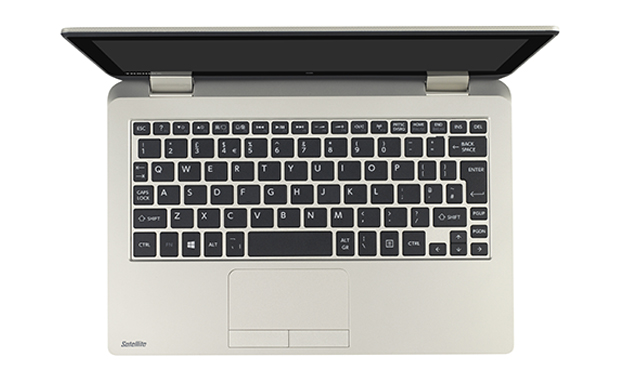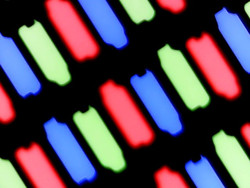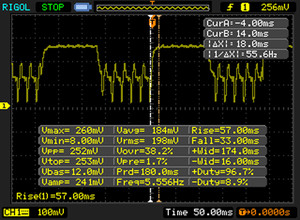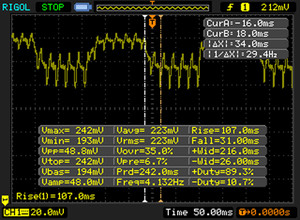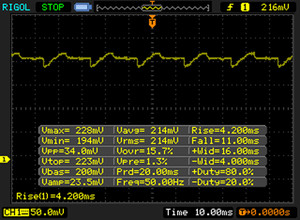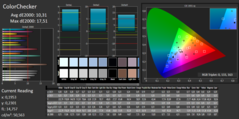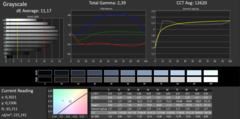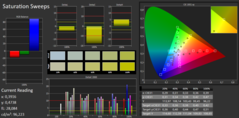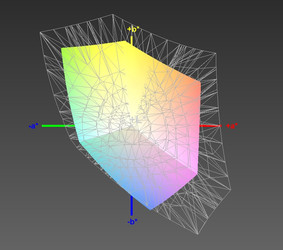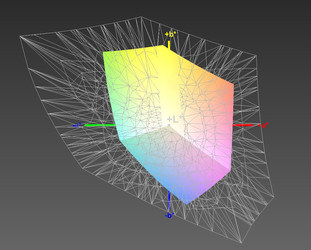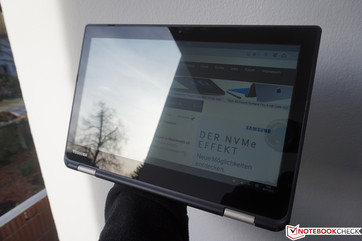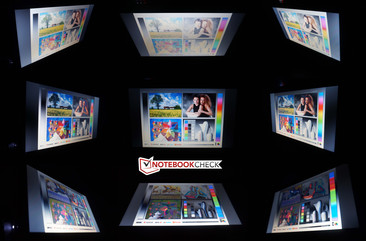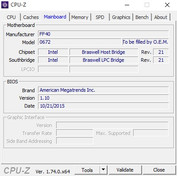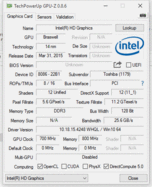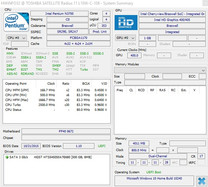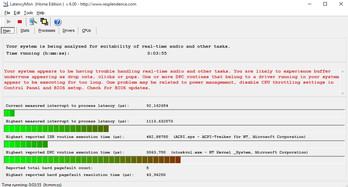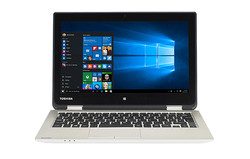Toshiba Satellite Radius 11 L10W-C-108 Notebook Review

For the original German review, see here.
Toshiba's Radius devices are convertibles with 360 degree hinges, so you can fold the display back. The Radius 11 L10W-C-108 is a very compact model with its 11.6-inch touchscreen. Inside the device are a frugal Intel Pentium N3700 processor, 4 GB of RAM and a 500 GB hard drive. We reviewed the predecessor Satellite Radius 11 L10-B-101 about a year ago.
Our review unit retails for around 500 Euros (~$543), so there are not many direct competitors. Many entry-level convertibles are significantly cheaper at around 300 Euros (~$326), while business devices can easily cost more than 1000 Euros (~$1086). We decided to use the following four comparison devices for this article: the Acer Aspire R11 R3-131T, the Acer Aspire Switch 11V, the Asus Transformer Book T100HA and the HP Pavilion x2 10 Convertible.
Case & Connectivity
Toshiba uses a silver plastic chassis for the Satellite Radius 11, which leaves a pretty compact and sturdy impression. The base unit can only be slightly twisted, which will cause a quiet creaking sound. The glossy lid is not quite as sturdy, and pressure from behind will cause picture distortions. The black display frame and the black keyboard create a nice contrast to the rest of the chassis. A maintenance hatch at the bottom is not available; you will have to remove the whole bottom cover to access the internals. The hinges are taut and keep the display well in position, even at wider opening angles. The power button and a volume rocker are located at the sides. They are well-integrated and easy to use.
The port variety is limited to the essentials. Besides two USB ports (1x 2.0, 1x 3.0), you also get a full-sized HDMI output and a card reader. The performance of the two USB ports is on the expected level (USB 2.0 ~40 MB/s; USB 3.0 ~100 MB/s), but the card reader is not one of the fastest modules. We measured a sequential transfer rate (read) of 29.2 MB/s and 14.9 MB/s when we copied normal JPEG pictures (5 MB each). We used the Toshiba Exceria Pro SDXC 64 GB UHS-II memory card that according to the manufacturer can reach up to 260 MB/s.
The network connectivity is limited to Wi-Fi and Bluetooth 4.0, but the device supports the 802.11 standards b/g/n only in 2.4 GHz networks. The less-crowded 5 GHz band or the fast ac-standard are not available. We did not experience any signal issues in an apartment building with several wireless networks.
Input Devices
The keyboard does not differ from the predecessor. Once again, the layout has shrunk due to the compact chassis dimension, so many keys have a different size. Toshiba certainly could have made more of the available space (~15 millimeters/~0.6 inches on both sides). The keyboard itself is a non-illuminated chiclet keyboard. We cannot say a lot of positive things about the keyboard since the typing experience is very uncomfortable due to the extremely short key travel. The situation is not improved by the different pressure points of the keys, either. The tiny arrow keys are very impractical and require a pretty good aim and they can hardly be used with larger fingers.
The touchpad with the dedicated mouse button leaves a better impression, at least with rudimentary inputs like cursor movements and tap-to-click inputs (1 or 2 fingers). Gestures like pinch-to-zoom, however, are rather tricky and we sometimes had problems with wrong inputs. The touchpad from Synaptics supports inputs with up to three fingers, which can be easily adjusted in the driver. The two dedicated mouse buttons also have a short travel, but create a rather loud clicking sound that leaves a cheap impression. However, there is no criticism in terms of reliability.
Besides the keyboard and the touchpad, you can obviously control the device via touchscreen. The latter offers decent gliding capabilities and is sensitive up into the peripheral areas, but the inputs are not always executed immediately. However, this is caused by the system performance, which can cause some delays (also see Performance) and not the touchscreen itself. It is tricky to control Windows in the normal mode, but it is okay in the tablet mode, despite the small display.
Display
Toshiba uses an 11.6-inch touchscreen with the resolution of 1366x768 pixels. The specification sheet advertises a high-luminance panel, but our measurements do not support this. Although the average brightness of just 220 cd/m² is not deplorable, it is not a good result. Annoying: The brightness is reduced to 183 cd/m² on battery power, which is especially important for such a compact convertible. This means that there can be restrictions in bright indoor environments due to the glossy panel surface, and you should look for a place in the shade when you want to use the device outdoors.
The low black value of 0.29 cd/m² and the decent contrast ratio of 762:1 are positive aspects. Subjectively, the picture is slightly pale and you can also notice a distinct blue cast.
| |||||||||||||||||||||||||
Brightness Distribution: 90 %
Center on Battery: 183 cd/m²
Contrast: 762:1 (Black: 0.29 cd/m²)
ΔE Color 10.31 | 0.5-29.43 Ø5
ΔE Greyscale 11.17 | 0.57-98 Ø5.3
60% sRGB (Argyll 1.6.3 3D)
39% AdobeRGB 1998 (Argyll 1.6.3 3D)
41.82% AdobeRGB 1998 (Argyll 2.2.0 3D)
60.3% sRGB (Argyll 2.2.0 3D)
40.42% Display P3 (Argyll 2.2.0 3D)
Gamma: 2.39
| Toshiba Satellite Radius 11 L10W-C-108 HD Graphics (Braswell), N3700, Hitachi Travelstar Z5K500 HTS545050A7E680 | Acer Aspire R11 R3-131T-C122 HD Graphics (Braswell), N3050, HBG3e 32G eMMC | Acer Aspire Switch 11V SW5-173-614T HD Graphics 5300, 5Y10c, Lite-On IT L8T-128L9G | Asus Transformer Book T100HA-C4-GR HD Graphics (Cherry Trail), Z8500, Samsung CGND3R eMMC | HP Pavilion x2 10-n013dx HD Graphics (Bay Trail), Z3736F | |
|---|---|---|---|---|---|
| Display | -7% | 19% | 26% | 6% | |
| Display P3 Coverage | 40.42 | 37.53 -7% | 48.29 19% | 52.8 31% | 42.71 6% |
| sRGB Coverage | 60.3 | 56.4 -6% | 70.5 17% | 73 21% | 64.1 6% |
| AdobeRGB 1998 Coverage | 41.82 | 38.81 -7% | 49.98 20% | 53.3 27% | 44.13 6% |
| Response Times | |||||
| Response Time Grey 50% / Grey 80% * | 80 ? | ||||
| Response Time Black / White * | 30 ? | ||||
| PWM Frequency | 50 ? | ||||
| Screen | -2% | 43% | 56% | 21% | |
| Brightness middle | 221 | 261 18% | 472 114% | 480.2 117% | 316.1 43% |
| Brightness | 220 | 248 13% | 448 104% | 455 107% | 294 34% |
| Brightness Distribution | 90 | 90 0% | 89 -1% | 85 -6% | 85 -6% |
| Black Level * | 0.29 | 0.3 -3% | 0.35 -21% | 0.324 -12% | 0.327 -13% |
| Contrast | 762 | 870 14% | 1349 77% | 1482 94% | 967 27% |
| Colorchecker dE 2000 * | 10.31 | 12.64 -23% | 6.33 39% | 3.45 67% | 6.18 40% |
| Greyscale dE 2000 * | 11.17 | 13.75 -23% | 6.76 39% | 2.67 76% | 5.51 51% |
| Gamma | 2.39 92% | 2.88 76% | 2.33 94% | 2.34 94% | 2.01 109% |
| CCT | 12620 52% | 17914 36% | 6214 105% | 6164 105% | 6510 100% |
| Color Space (Percent of AdobeRGB 1998) | 39 | 36 -8% | 46 18% | 47.28 21% | 40 3% |
| Color Space (Percent of sRGB) | 60 | 57 -5% | 70 17% | 84.38 41% | 64 7% |
| Total Average (Program / Settings) | -5% /
-3% | 31% /
37% | 41% /
49% | 14% /
17% |
* ... smaller is better
Display Response Times
| ↔ Response Time Black to White | ||
|---|---|---|
| 30 ms ... rise ↗ and fall ↘ combined | ↗ 18 ms rise | |
| ↘ 12 ms fall | ||
| The screen shows slow response rates in our tests and will be unsatisfactory for gamers. In comparison, all tested devices range from 0.1 (minimum) to 240 (maximum) ms. » 77 % of all devices are better. This means that the measured response time is worse than the average of all tested devices (21.5 ms). | ||
| ↔ Response Time 50% Grey to 80% Grey | ||
| 80 ms ... rise ↗ and fall ↘ combined | ↗ 46 ms rise | |
| ↘ 34 ms fall | ||
| The screen shows slow response rates in our tests and will be unsatisfactory for gamers. In comparison, all tested devices range from 0.2 (minimum) to 636 (maximum) ms. » 99 % of all devices are better. This means that the measured response time is worse than the average of all tested devices (33.7 ms). | ||
Screen Flickering / PWM (Pulse-Width Modulation)
| Screen flickering / PWM detected | 50 Hz | ≤ 50 % brightness setting | |
The display backlight flickers at 50 Hz (worst case, e.g., utilizing PWM) Flickering detected at a brightness setting of 50 % and below. There should be no flickering or PWM above this brightness setting. The frequency of 50 Hz is very low, so the flickering may cause eyestrain and headaches after extended use. In comparison: 53 % of all tested devices do not use PWM to dim the display. If PWM was detected, an average of 17903 (minimum: 5 - maximum: 3846000) Hz was measured. | |||
Our subjective impression is supported by the CalMAN measurements. The average DeltaE deviation compared to the sRGB standard is 10.31 for the colors ex-works; some outliers even exceed 17. The grayscale deviation is also very high at 11.17 and we can see the strong blue cast. The target deviation of both values is less than 3.
The viewing angle stability is typical for a TN panel: The panel managed horizontal shifts pretty, but you will quickly notice brightness and contrast losses as well as color inversions when you change the viewing angle vertically. The performance is particularly bad for a convertible, where you often look at the display from different angles when you use it as a tablet.
Performance
With its Pentium quad-core processor and 4 GB of RAM, the Toshiba Satellite Radius 11 is powerful enough for simple tasks like office activities (write letters, presentations, mails) and web browsing, but the small device will quickly reach its limits in more demanding situations like picture or video editing. You also benefit from the advanced video unit when you watch videos, because it has no problem with H.265 movies. The tool LatencyMon shows delays, which can cause issues during real-time audio or video processing.
Processor
The Intel Pentium N3700 is a quad-core processor based on the Braswell platform. It is manufactured in a 14 nm process and has a very low TDP of just 6 watts, so it can be cooled passively. The four cores can still reach up to 2.4 GHz (Burst).
The performance of the Pentium processor in the Cinebench tests is roughly on par with the Atom-X5-Z8500 in the Asus Transformer Book T100HA. They manage an identical score in CB R15 Single and our review unit is around 5% faster in the Multi test. The Celeron N3050 inside the Acer Aspire R11, which is also based on the Braswell platform, keeps up pretty well in the Single test (-3%), but has a clear disadvantage in the Multi test (-64%) due to the lower number of cores (two). In this comparison the Core-M of the Acer Aspire Switch, which is between 22% (Multi) and 108% (Single) faster, is ahead of our review unit. More information about the Pentium processor is available in our Tech-section.
| Cinebench R10 | |
| Rendering Single CPUs 64Bit (sort by value) | |
| Toshiba Satellite Radius 11 L10W-C-108 | |
| Acer Aspire R11 R3-131T-C122 | |
| Asus Transformer Book T100HA-C4-GR | |
| Rendering Multiple CPUs 64Bit (sort by value) | |
| Acer Aspire R11 R3-131T-C122 | |
| Asus Transformer Book T100HA-C4-GR | |
System Performance
You quickly notice that the conventional hard drive of the review unit is the bottleneck when you use the device. Unlike the flash-based rivals, you get a much higher storage capacity, but the subjective performance impression is worse. You will be wondering about some small delays when you are already used to devices with flash storage in particular. However, in general, the system runs well when you keep an eye on the resources and the number of processes.
The Radius 11 does not stand a chance against the rivals and usually lands on the last place in PCMark 7, which benefits heavily from flash storage. Our review unit can only beat the Acer Aspire R11 with the Celeron processor in the Computation sub-score, which is focused on the CPU.
| PCMark 7 Score | 1778 points | |
Help | ||
Storage Devices
The hard drive Hitachi Travelstar Z5K500 has a capacity of 500 GB and works with 5400 rpm. HD Tune determines an average transfer rate of just 82 MB/s, which is an average result for this type of drive. The subjective impression in practice is mainly affected by the comparatively high access time of 19.2 ms. More information and benchmarks are available in our constantly growing HDD/SSD comparison.
GPU Performance
The graphics are handled by the integrated HD Graphics (Braswell). We get the most powerful version of this GPU with 16 EUs (Execution Units) and a core clock of 700 MHz in combination with the Pentium N3700. The graphics card shares the memory with the system, so the performance also benefits from the dual-channel memory configuration.
The 3DMark benchmarks show that the graphics card is only beaten by the HD Graphics 5300 of the Acer Aspire Switch 11V, the other comparison devices fall behind. This is not a bad result, but we are still on a pretty low performance level in general. More benchmarks of the HD Graphics are available here.
| 3DMark | |
| 1920x1080 Fire Strike Score (sort by value) | |
| Toshiba Satellite Radius 11 L10W-C-108 | |
| Acer Aspire Switch 11V SW5-173-614T | |
| Asus Transformer Book T100HA-C4-GR | |
| 1280x720 Cloud Gate Standard Score (sort by value) | |
| Toshiba Satellite Radius 11 L10W-C-108 | |
| Acer Aspire R11 R3-131T-C122 | |
| Acer Aspire Switch 11V SW5-173-614T | |
| Asus Transformer Book T100HA-C4-GR | |
| 1280x720 Ice Storm Standard Score (sort by value) | |
| Toshiba Satellite Radius 11 L10W-C-108 | |
| Acer Aspire R11 R3-131T-C122 | |
| Acer Aspire Switch 11V SW5-173-614T | |
| Asus Transformer Book T100HA-C4-GR | |
| 3DMark 11 Performance | 447 points | |
| 3DMark Ice Storm Standard Score | 23867 points | |
| 3DMark Cloud Gate Standard Score | 2134 points | |
| 3DMark Fire Strike Score | 256 points | |
Help | ||
Gaming Performance
The gaming performance is not one of the strengths of the Satellite radius 11. We tested the game “Tomb Raider” from 2013, but we did not manage smooth frame rates even with our low preset (1024x768 pixels, low details). You should focus on games from the Windows Store if you still want to play. These run without problems and make much better use of the touchscreen. The hardware requirements of many other games are available in our Gaming list.
| low | med. | high | ultra | |
| Tomb Raider (2013) | 22.5 | 12.9 | 9.1 |
Emissions & Energy
System Noise
Thanks to the frugal Pentium processor, the Radius 11 can be cooled passively. Therefore, the only source of noise is the mechanical hard drive. However, it is not one of the fastest drives at 5400 rpm and not too loud at 32.4 dB(A). It is also a pretty steady murmur, so it is hardly annoying.
Noise Level
| Idle |
| / / dB(A) |
| HDD |
| 32.4 dB(A) |
| Load |
| / dB(A) |
 | ||
30 dB silent 40 dB(A) audible 50 dB(A) loud |
||
min: | ||
Temperature
Because of the passive cooling solution, the temperatures are obviously higher compared to actively-cooled devices. We can measure almost 35 °C (~95 °F) at the bottom while idling, but this is not uncomfortable yet. It gets more inconvenient at almost 50 °C (~122 °F) in the stress test, but those temperatures should be rare in practice.
The stress test quickly reveals the limitations of the passive cooling solution and the low TDP, because both the processor as well as the graphics card immediately throttle to 480 and 400 MHz, respectively, which does not change over the course of the test. The processor does not exceed 70 °C (~158 °F).
(-) The maximum temperature on the upper side is 46.1 °C / 115 F, compared to the average of 35.3 °C / 96 F, ranging from 19.6 to 55.7 °C for the class Convertible.
(-) The bottom heats up to a maximum of 49 °C / 120 F, compared to the average of 36.7 °C / 98 F
(+) In idle usage, the average temperature for the upper side is 28.6 °C / 83 F, compared to the device average of 30.2 °C / 86 F.
(-) The palmrests and touchpad can get very hot to the touch with a maximum of 40.3 °C / 104.5 F.
(-) The average temperature of the palmrest area of similar devices was 28.1 °C / 82.6 F (-12.2 °C / -21.9 F).
Speakers
The Radius 11 has two speakers, which are located on the lower part of the front. The maximum volume is sufficient, but there are distortions when you exceed around 75%. The DTS Sound software is active by default, and it should stay active. But even with this improvement, the "sound" is still focused on the high tones and is only sufficient for (quiet) background music or occasional YouTube videos at best. Therefore, we suggest that you either attach headphones or external speakers, which is possible via stereo jack, HDMI or Bluetooth. You should also deactivate the DTS software in this case.
Power Consumption
The review unit should be a pretty frugal device considering the low resolution, the low brightness of the screen and the frugal SoC. However, we were pretty surprised by the high idle measurements for the Radius 11 (5 to 8.7 watts) in particular. Only the Acer Aspire Switch 11V consumes even more power, but this is a result of the much higher FHD resolution and the higher luminance. The load consumption is also pretty high in comparison at up to 16 watts. The manufacturer included a generously-sized power adapter, because the compact 45-watt module is not really stressed at all.
| Off / Standby | |
| Idle | |
| Load |
|
| Toshiba Satellite Radius 11 L10W-C-108 HD Graphics (Braswell), N3700, Hitachi Travelstar Z5K500 HTS545050A7E680 | Acer Aspire R11 R3-131T-C122 HD Graphics (Braswell), N3050, HBG3e 32G eMMC | Acer Aspire Switch 11V SW5-173-614T HD Graphics 5300, 5Y10c, Lite-On IT L8T-128L9G | |
|---|---|---|---|
| Power Consumption | 39% | -10% | |
| Idle Minimum * | 5 | 2.8 44% | 6.5 -30% |
| Idle Average * | 7.8 | 4.7 40% | 7.9 -1% |
| Idle Maximum * | 8.7 | 4.9 44% | 9.9 -14% |
| Load Average * | 14.3 | 9.9 31% | 15.3 -7% |
| Load Maximum * | 16 | 10.6 34% | 15.6 2% |
* ... smaller is better
Battery Runtime
The bad result in our realistic Wi-Fi is not really surprising when you consider the high consumption. We use the test to simulate web browsing at an adjusted brightness of 150 cd/m². The Satellite Radius 11 does not even last four hours, which is by far the worst result within the comparison and way too short for a supposedly mobile device.
| Toshiba Satellite Radius 11 L10W-C-108 HD Graphics (Braswell), N3700, Hitachi Travelstar Z5K500 HTS545050A7E680 | Acer Aspire R11 R3-131T-C122 HD Graphics (Braswell), N3050, HBG3e 32G eMMC | Acer Aspire Switch 11V SW5-173-614T HD Graphics 5300, 5Y10c, Lite-On IT L8T-128L9G | Asus Transformer Book T100HA-C4-GR HD Graphics (Cherry Trail), Z8500, Samsung CGND3R eMMC | HP Pavilion x2 10-n013dx HD Graphics (Bay Trail), Z3736F | |
|---|---|---|---|---|---|
| Battery Runtime | |||||
| WiFi v1.3 | 222 | 680 206% | 302 36% | 541 144% | 460 107% |
Pros
Cons
Verdict
After the review of the Toshiba Satellite Radius 11, there are mainly negative impressions that do not really suit the comparatively high price tag. The positive aspects include the chassis, which is well-built and sufficiently sturdy. The hinges are also taut and keep the display well in position. The performance of the system is decent as well, even though the flash-based competition has a subjective advantage in practice.
We cannot recommend the Toshiba Satellite Radius 11 for the price of 500 Euros (~$543). Except for the slightly higher performance, it does not have any advantages over the rivals for 300 Euros (~$326) and is even clearly beaten in some important aspects.
The convertible cannot impress in some important aspects, starting with the display and its mediocre luminance, the keyboard and the short battery runtime. Even the comparison devices for 300 Euros (~$326) are sometimes much better.
Toshiba Satellite Radius 11 L10W-C-108
-
04/18/2016 v5.1(old)
Andreas Osthoff


 Deutsch
Deutsch English
English Español
Español Français
Français Italiano
Italiano Nederlands
Nederlands Polski
Polski Português
Português Русский
Русский Türkçe
Türkçe Svenska
Svenska Chinese
Chinese Magyar
Magyar






